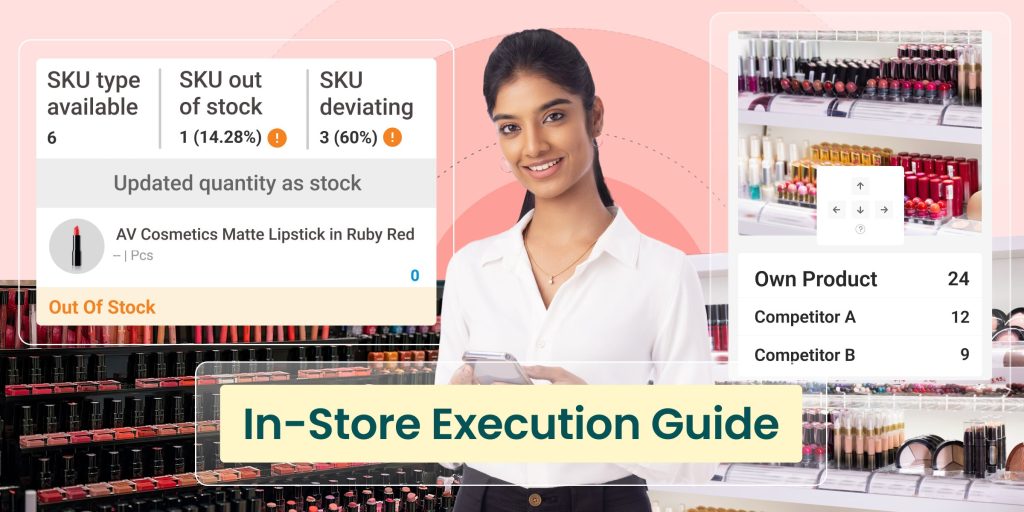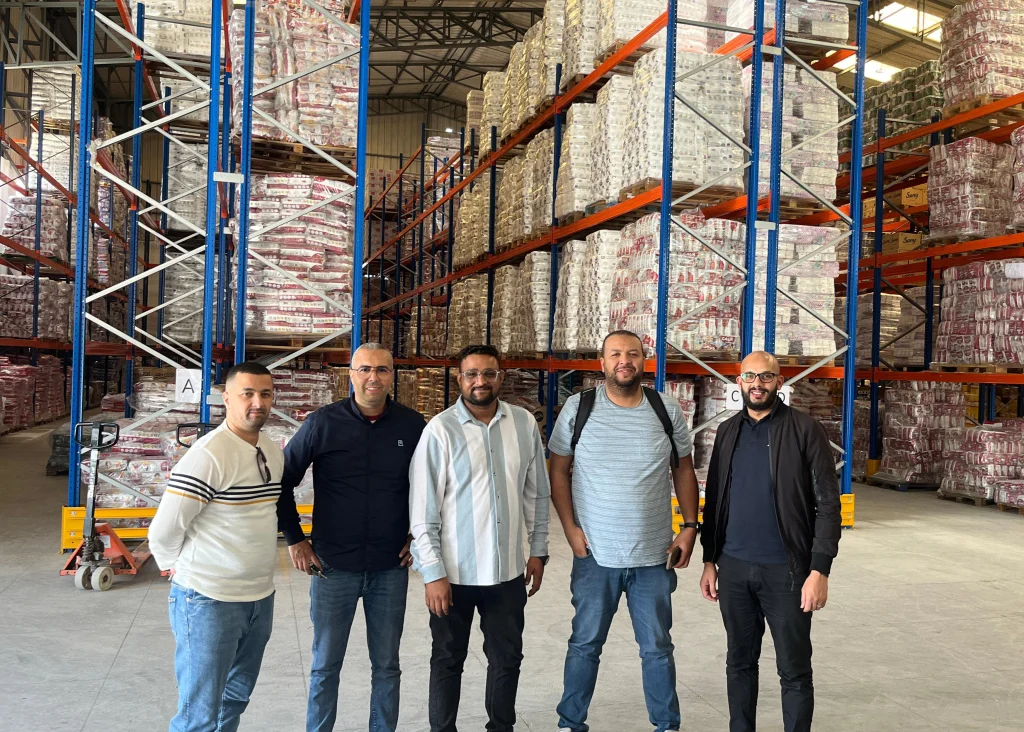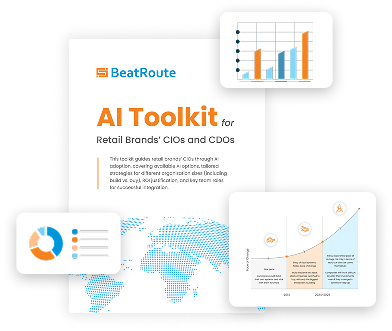The Complete In-Store Execution Guide That Your Brand Needs

There is no magic involved behind an effective display or arrangement of products on store shelves or how easily your consumers are directed towards your brand. Instead, enhancing consumer experience with effective in-store execution is a matter of deliberation, detailed insights, foresight, discussions, and planning.
To make that happen, a combination of human effort and software is crucial. While the human element is invaluable to understand consumer psychology, software can offer automation and analytical data without which any in-store execution strategy is inadequate.
On that note, let’s find out everything you need to know about in-store execution – from best practices to benefits to pitfalls to what we offer in this space.
What is In-Store Execution?
In-store execution is the process that encompasses all strategies focused on presenting, displaying, and marketing your brand or product to consumers. The purpose of such a strategy is pretty straightforward; fostering positive and consistent experiences that will in turn enhance sales and visibility. The whole thing brings together planning, organisation, and implementation under one roof for more optimised interactions with consumers.
Every Type Of In-Store Execution
In-store execution refers to a series of strategies that play significant roles in highlighting your products, boosting consumer experience, and driving sales. These can range from visual merchandising efforts to managing inventory and optimising your supply chain. It is anything and everything that adds to a better store experience for consumers that leads to a competent bottomline for your company.
- Planogram
Planogram compliance is what makes your products stand out in the store. The arrangement, lighting, shelf space, and positions all matter to enhancing consumer experience that leads to better offtake.
- Inventory control
To keep up with rising demand or consumer expectations, it is very necessary that your inventory is always fully stocked. At the same time, you mustn’t go overboard as overstocking can lead to ruinous results where your surplus stocks go bad and you lose money. Figure out what’s in vogue right now, what consumers are buying more, and stock accordingly.
- Store layout
Store layout tells you an aspect of what you can do and cannot do towards your in-store execution efforts. For example, you can’t put up a visi-cooler in a store unless you have space or a spot readily visible to consumers.
- Displays
Displays, both digital and physical, are the foundation of any in-store experience. Of course, your products are the endgame, but strategically placed, catchy displays are what draw consumers to your offerings.
- Training
Training your product promoters and the store manager on what you are offering, pros and cons of your product, USP, etc. will go a long way in establishing a well-oiled system in the store that promotes your products. Your product is more likely to be pushed to consumers in such stores.
- Product placement
Strategically placed products affect the consumer psyche to benefit you. For example, a product near the POS will reap greater dividends than when it’s placed at the back of the store. Remember, your items must not only be visible clearly but must also appeal to a potential buyer, even if as an impulse.
- Sampling
As humans, it is in our nature to love giveaways. Sampling at stores is a form of giveaway, free of charge. It allows consumers to try what you are offering without the compulsion of buying it. You give them a taste and the experience (presumably good) drives them to return for purchases. You must use this as a selling point for your brand to attract more consumers in the store.
- Audits
To ensure that all in-store efforts are up to par with your existing strategy, auditing is a step you cannot ignore. Problems are inevitable, and therefore, audits help with identifying and fixing these, enabling you to re-strategize in time. As a result, you can get your in-store execution back on track. Audits cover visual merchandising efforts including signage and planogram, quality, competitor product analysis, etc.
The Benefits Of Successful In-Store Execution
Convenience shopping is a big deal for today’s consumers. Not that it was non-existent before, but with the advent of more and more modern technology, the mountain of benefits they bring, and the fact that we are more accustomed to comfort today than ever before, all contribute to this mindset. The easier you make it for your consumers to see, browse, and pick up your offerings, the more sales you will be enjoying!
- More attention
The immediate benefit that you notice when you successfully execute your in store strategy is how much your consumers are drawn to your products. After all, you want your customers to be at ease when browsing through what you have that then leads to quick offtake.
- More sales
The moment you make it easier for consumers to notice your products, you can immediately expect a rise in sales. This is not a 100% fool-proof rule but it is a highly successful tactic. The best brands don’t just have an idea for a new product, they think steps ahead on how to push the product in the market. Retail stores are one of the best ways to do that because they offer a physical experience for the buyer. With adequate marketing effort, strategizing, and some creativity, your in-store execution will translate to wonderful in-store experiences for consumers, leading to sales.
- Stock availability
In-store execution informs on the quality and availability of products on shelves. This means that successful in-store execution ensures the store in question is always well-stocked with untampered items. Consumers who visit the store will be able to pay your product the necessary attention that can then turn into a purchase.
- Brand awareness
Brand execution strategies such as displays or sampling are excellent ways to make consumers aware of your brand. It’s all about appealing to someone’s psyche where the more they are exposed to your product or messaging about your product/brand, the more likely they are to remember you. This can even lead to consumers preferring your product over others’. A positive side effect of this is where they talk about your brand more and spread the word, further enhancing your brand awareness.
- Cross-selling opportunities
In-store execution involves the appropriate placement of product types where one product complements another. For example, placing milk and butter side by side stimulates the consumer’s imagination about the breakfast table on a subconscious level. They find themselves purchasing milk and butter because you have ensured simultaneous visibility of both products, driving successful cross selling.
- Memorable experiences and consumer loyalty
Efforts such as store layout, sampling, and training can lead to incredibly seamless experiences for your consumers. For example, you can set up a convenient sampling station in the store where consumers get to taste your read-to-eat food item or maybe your candy product. What this will do is not only make them aware of your product quality but also form a good memory in their minds. And good memory generates an emotional response, which is a psychological driver that always pays dividends. Consumers who have enjoyed their experience around your brand or product will be loyal to you and keep returning for more!
Best Practices of In-Store Execution
As successful in-store execution often translates to sales performance, it is important to be mindful of some best practices that will consolidate your efforts.
- Nurture relationships with your retailers
Remember that all your strategies of in-store execution depend on the assent of your retailer. In other words, you can’t go forward with a plan unless both you and the store are in agreement. Elements such as shelf space or even floor space to position your product are provided by your retailer when they prefer your business over your competition’s. The way to do this is to maintain a human connection with your retailer such as regular face time, special discounts when they buy from you, robust customer support to resolve issues promptly, and product awareness.
- Attract with packaging
Your packaging may not speak for your quality or reliability, but it does leave a mark in the minds of your consumers. A well-packaged product with colours that pop will win the battle for attention any day! As a consequence, good packaging affects your retailer’s purchase habits too as any product that is a potentially good selling opportunity for you is a revenue upliftment for them too.
- Promote, promote, and promote
Promotions is the name of the game when you are trying to sell anything. If you have a top-notch product and you want retailers and consumers to be receptive to it, you cannot bypass a well-rounded promotional campaign. This is true for consumers because promotions appeal to their buying nature and true for retailers because attractive promotions make you appear more reliable. Banners, electronic or physical displays, flyers, sampling, and strategic discounts all contribute to successful in-store execution.
- Set up a reward system
A large part of your in-store execution is the culmination of a number of planned activities undertaken by your sales reps or merchandisers. Naturally, it is important that they do their job properly so that your strategies can end up successful. It is important that you keep them motivated with a well-structured system that rewards them for reaching milestones in time. These can be coupons or redeemable points or even physical gifts; anything that makes their efforts feel appreciated.
- Cross-team collaboration
Your marketing, merchandising, and sales teams must work together for continued success. For instance, merchandisers or marketers must be privy to sales performance to be able to accurately formulate strategies and creative displays that support brand goals. For instance, low-selling products might need an extra push or merchandising might need redoing because consumers don’t like the current display designs. Only collaboration and transparency on all levels will facilitate timely modifications in these areas.
- Consumer surveys
Regular consumer surveys will give you an idea of where your product stands in terms of popularity. Feedback helps you decide whether you need enhancements or to scrap the product altogether. Your in-store execution is inconsequential to your sales if you keep doing something redundant and therefore, surveys are super useful.
- Execute data-based innovation
Knowing things on a shelf level gives you perspective that you wouldn’t get otherwise. Get a handle on elements such as product availability and placement, promotions, and competitor proximity to your shelf that may affect purchase decisions. A powerful AI-backed tool can document and analyse seemingly insignificant details, such as shelves that see the most sales or lighting that works best.
The Future of In-Store Execution With BeatRoute
At BeatRoute, we provide brands with a platform that empowers every level of their route-to-market. But in the scope of in-store execution, we allow your sales reps, promoters, and merchandisers to work in tandem with retailers for best results. When everyone is clued in on what’s happening presently in the store, what needs to happen, and how to get there, there is less of a chance to go wrong.
We predict the future to be a mix of online and physical shopping, where with progressing technology, there will come a time when the omnichannel experience will become more streamlined. As we leverage artificial intelligence to boost human efforts, we also see its application in retail growing with time and increase in efficiency. Naturally, future store execution efforts will have to account for such changes.
With time, you will possibly need to handle greater workloads (larger product line), hire more people to handle said workload (more merchandisers or sales reps), train them (more educational videos), and process more data, all the while saving on costs. This would require a highly scalable platform that can adapt to expansion without crashing or limiting you. Additionally, multi-integration capability is equally critical to ensure real-time data visibility and operational efficiency, leading to better decisions and success.
Our application is designed for all of these and can even function in low-internet areas to minimise disruptions in your field activities. We also recognise mobile technology as an important component of future retail practices because of the accessibility and ease it offers businesses and their sales teams.
Need help making up your mind? Check out our free demo for you!
About the Author
-
Apart from being a Senior Content Writer at BeatRoute, Soham is an avid reader of science fiction and suspense novels (Doyle, Christie, Brown or anybody great!) He also dabbles in historical narratives and wonders about our place in the universe. Cosmic viewpoints, Carl Sagan, and Neil deGrasse Tyson intrigues him. When not reading, you may find him spending his weekends or after-work hours watching a fulfilling movie with his family.
Use Goal-Driven AI to Achieve Retail Sales Uplift, Today!
Join enterprises in 20+ countries that trust BeatRoute, the globally dominant AI platform for sales force automation, field sales, DMS, and eB2B
Latest Insights & Articles
Here are the most impactful articles, platform updates, ebooks and reports for you.



